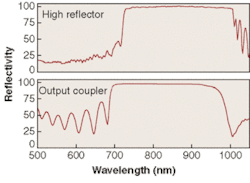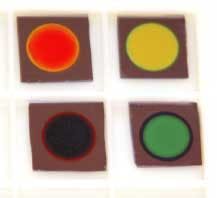A research team based at the University of New South Wales (Sydney, Australia) has designed, fabricated, and tested laser mirrors made entirely from porous silicon (PSi). This new fabrication technique can produce very broadband mirrors at a low cost and could also be used to produce very large mirrors. The optics tested so far include high reflectors and output couplers for continuous-wave and modelocked Ti:sapphire lasers operating between 730 and 940 nm, as well as for dye lasers. The team claims that the optics did not introduce measurable dispersion and were not damaged by relatively high optical powers.
Refractive index is a function of porosity in PSi. The principle of the production technique is to electrochemically etch alternating layers of high and low porosity, and hence refractive index, into the silicon substrate to make a multilayer reflector. To produce mirrors with broad spectral bandwidth, the ratio between the refractive indices of the high and low refractive-index layers must be large. The highest practically achievable ratio is 2.86/1.33 at 780 nm, which corresponds to a porosity ratio of 27%/85%. Porosity is limited at the top end by the mechanical instability of highly porous structures, and at the bottom end by the slow etching rates that have to be used to create controlled low porosity.
null
Mike Gal's New South Wales team uses highly boron-doped p+-type (100) silicon wafers as the starting material. The silicon substrate is electrochemically etched in a solution of 35% hydrofluoric acid, using an electrolyte at -22.5°C. Gal maintains that this low-temperature process ensures a more homogenous porosity, which in turn produces less scattering and therefore better-quality optics.
The high-reflection mirror for the Ti:sapphire laser was fabricated with porosities of around 34% and 77% for the high- and low-refractive-index layers respectively. The measured reflectivity of the mirror was more than 98% between 730 and 1000 nm, which means that a single mirror pair could be used to cover the complete tuning range of the laser. Reflectivity was between 99.4% and 99.5% around the spectral peak of the gain curve of Ti:sapphire, which is between 760 and 800 nm. Producing a partially transmitting optic for the output coupler is more complicated because the silicon substrate absorbs light in that spectral region. To get around this problem, the etched multilayer output-coupler structure is lifted from its substrate by applying a current pulse. The mirror can then be attached to a different substrate, such as quartz, which has no absorption bands in the wavelength range of the output. Gal believes a similar technique could be used to make spherical PSi mirrors, attaching the etched mirror to curved substrates.
The PSi mirrors have been tested by the team in a commercial 5-W argon-ion-laser-pumped Ti:sapphire laser in both continuous-wave and modelocked types of operation. The optics produced stable output power and produced 80-fs pulses of modelocked light, which was the same as the pulse length achieved with the commercially produced mirrors. There weren't any apparent signs of deterioration in any aspect of performance over the three-month period of the trial. Mirrors have also been tested on a dye laser with 6G-rhodamine dye.
Compared with evaporators used in conventional multilayer mirror-production methods, the relatively low-cost capital equipment makes PSi mirrors an attractive proposition. In addition, flexibility offers technical advantages. Gal explains where he hopes to take this technology. "The refractive index of PSi can be continuously varied, not only in discrete steps as with most other systems," he says. "For example, we can make sinusoidal or exponential refractive-index profiles, among others. This continuous variation of the refractive index gives us extra flexibility in the design of new optical structures. Porous silicon is an excellent optical material that should be seriously considered for devices in the near-IR and IR part of the spectrum."
Team member Peter Reece outlined another way forward for PSi mirrors. "We believe that PSi will allow us to make integrated optical devices on silicon wafers," he says. "We are now working on integrating PSi mirrors with silicon-based light-emitting structures to make a silicon-based laser."


